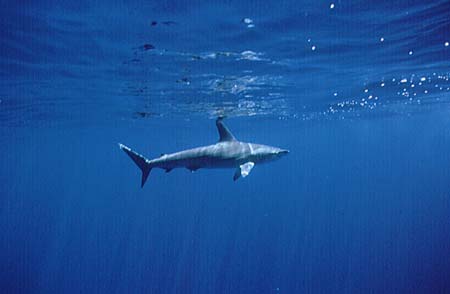|
By Volker Berbig

|
A smooth hammerhead shark (Sphyrna zygaena).
© Innerspace Visions / Shark Foundation
|
|
In the Mediterranean region, on the Altantic Coast and anyplace where ports serve as tourist
attractions they can be found: small and large-sized oceanaria and aquaria which show
tourists the local species of fish, sharks and invertebrate fauna. Caleta de Fuste on
Fuerteventura is one such place, a vacation paradise which also houses such an oceanarium next
to the port. When such institutions are managed professionally and with scientific support,
they no doubt serve to acquaint visitors with endemic marine flora and fauna. Unfortunately,
in Caleta de Fuste various fish and invertebrate species were thrown together in small pools
without any scientific assistance. Apparently no one was interested in the fact that several
of the species put together in the same basin could lead to problems. Designed to step up
ticket sales, it was concipated as an additional attraction next to the rides with the
glass-bottom boat.
In order to guarantee a really sweeping success an additional pool was built and part of the
open port was sectioned off for the purpose of holding hammerhead sharks (Sphyrna zygaena) in
captivity. No scientists were consulted for the first part of the project, so it was not
surprising that those responsible paid no attention to maintaining the sharks' natural
environment. They simply hired a deep-sea fisherman to catch a hammerhead shark and bring it
into port.
Sharks and other large fish such as swordfish or tuna are often seriously hurt when they are
caught with fishing lines and hooks. If and when they even survive this ordeal they usually
wind up with injuries, even in cases where they are released afterwards. Although deep-sea
fishermen say that "tag and release" fishing does not hurt the animals, it still remains a
questionable justification of this more than dubious "sport".
As could be expected, the first hammerhead did not survive being caught. In a second attempt
they succeeded more or less in dragging another hammerhead -more dead than alive - into the
basin. The fact that this animal was almost killed by its being dragged tail-first behind the
boat interested no one. The fishermen did not know that sharks cannot procure more than about
20% of life-giving oxygen through their gills when the water streams in from the opposite
side, i.e. from back to front over the gill openings. When the animal's oxygen supply is
reduced to such a low extent its tail region begins to stiffen. This in turn influences its
swimming movements, and, in worst case, even causes them to block completely. And since sharks
must constantly swim in order to breathe, the result is a vicious circle which can end in
immobility and even death.
In this case, the fishermen wound up throwing an almost suffocated, alarmlingly stiff animal
into the harbor basin.
Once in the basin they tried to reanimate the almost three meter long animal by pushing it
through the water in order to increase the flow of water through the gills so that it could
breathe in sufficient oxygen. In this way they hoped to rescind the stiffness. But the animal
had suffered an additional serious injury. It had a large wound on the hammer, probably caused
by a hook or gaff (a pole with a hook used to heave sharks and fish on board ships).
After almost an hour in the basin, the animal began to wind and bend, thrashing the water
several times before going limp. It died 20 minutes later.
Unfortunately, those responsible learned absolutely nothing from this experience. What first
appeared to be a single tragedy repeated itself only one day later as two new hammerheads were
thrown into the basin at the same time. It could not be determined where these two animals
came from, but presumably they too were caught with bait and hooks and then dragged into the
port basin. Both hammerheads survived the first two days, but one of them had bite marks on
its hammer. When sharks bite to such an extent it means they feel cramped due to the lack of
sufficient space to move around in. It comes as no surprise that even at this point those
responsible did not recognize the signs and give the shark its freedom. The injured shark thus
died within a week.
A nearby diving school which maintained good relations to the local police, the Guardia Civil,
alarmed their animal protection department. They succeeded in enforcing a ban on the capture
of additional sharks and also ordered the release of the remaining animal in the basin. The
oceanarium was also forced to call in a marine biologist at regular intervals to examine the
animals and control their health. Such controls are an important step in making sure that
animals held in captivity are kept under conditions which resemble their natural environment
as close as possible. Unfortunately, as long as these controls are only carried out in certain
prescribed intervals and as long as no species inventory list exists, additional animals can
be caught and put into the oceanarium and again be long gone by the time the next control
takes place.
* Volker Berbig Deep Blue S.L.,
Caleta de Fuste, Fuerteventura
May be published only by indicating the source: Shark Info / Volker Berbig
|

